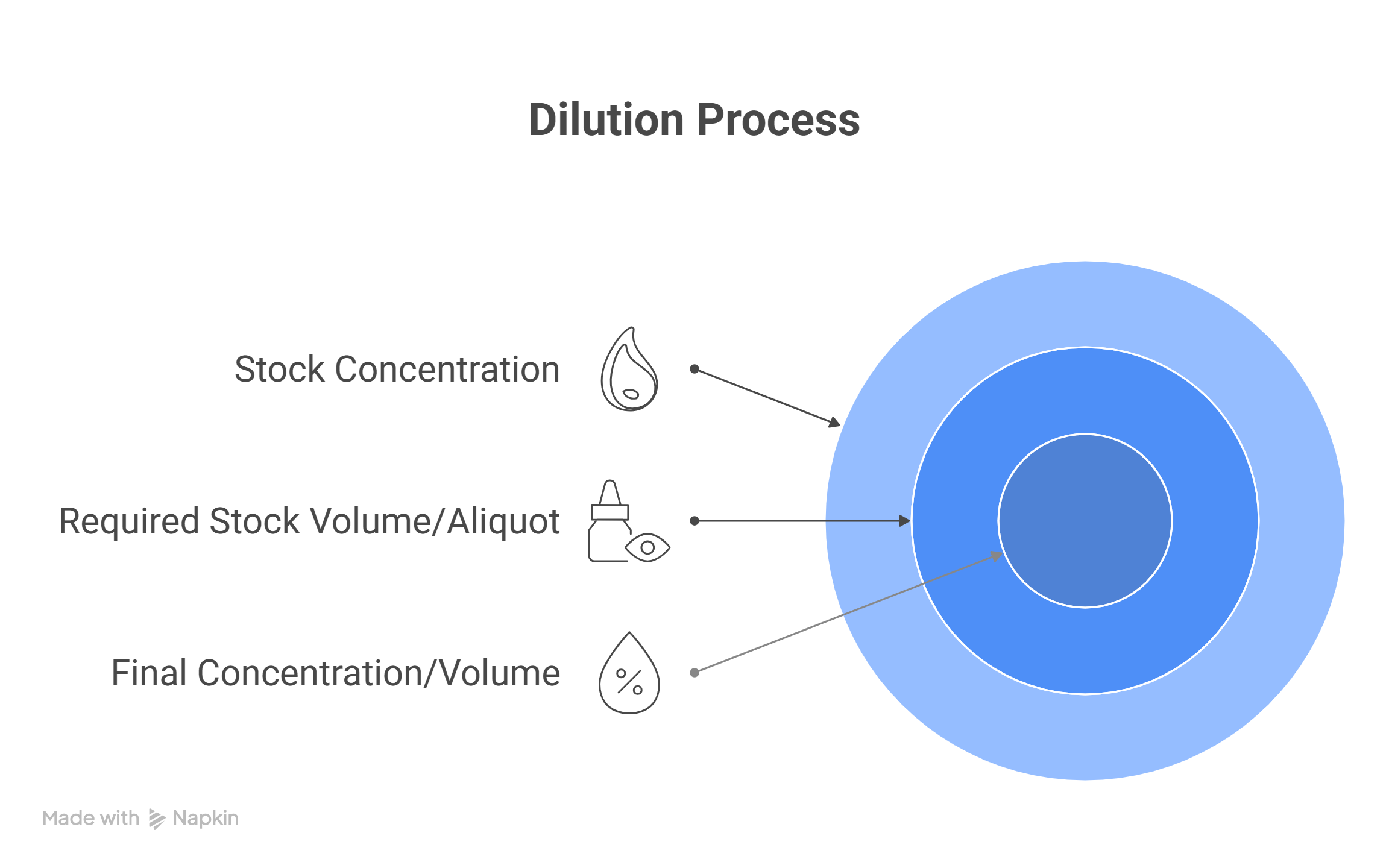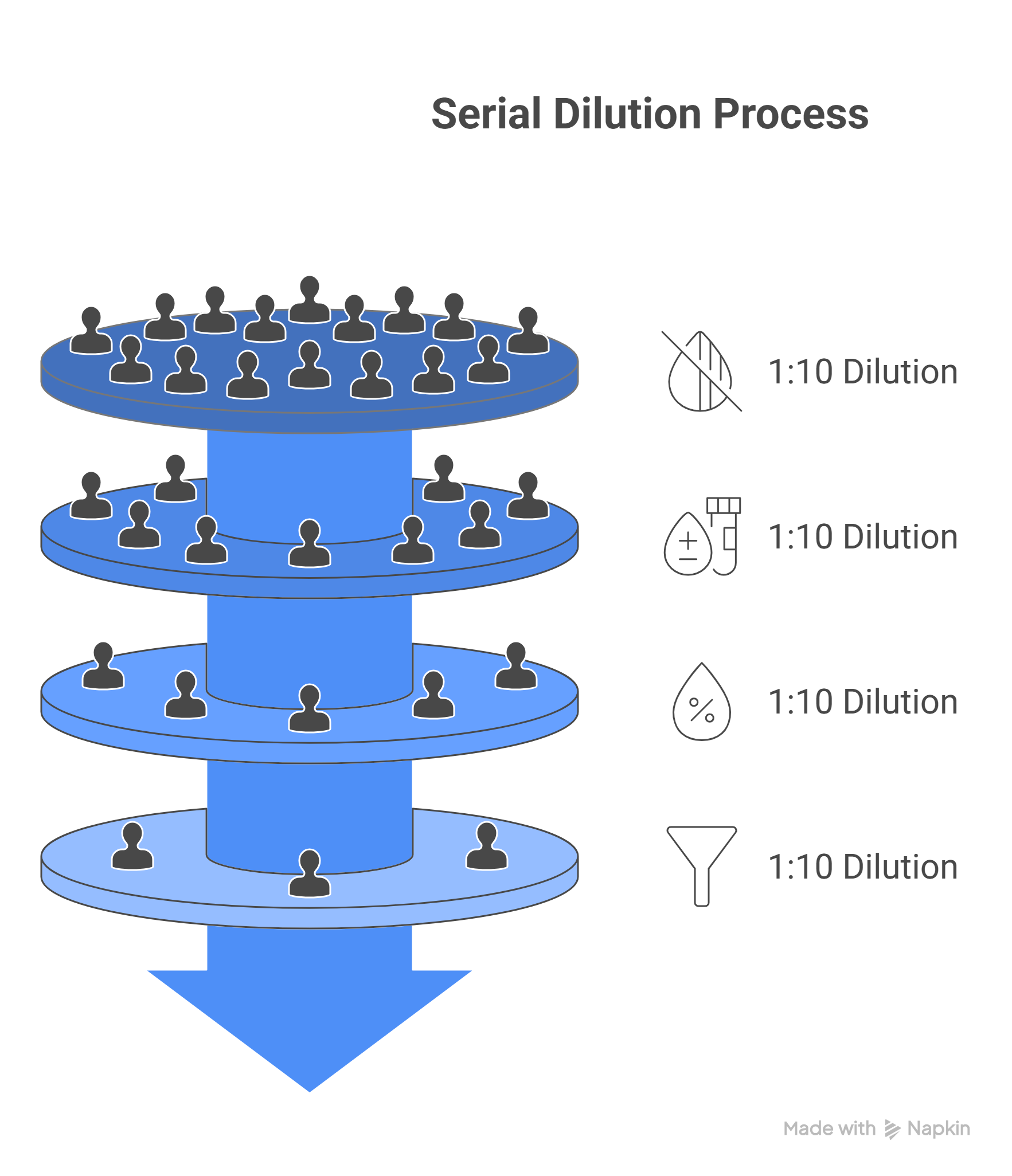Cell Dilution Calculator
Calculate cell concentrations, dilution factors, and preparation volumes for cell culture work.
Factor used before counting (1 for undiluted)
Volume loaded into counting chamber
Concentration Results
Dilution Results
Dilution Protocol
Serial Dilution Protocol
| Step | Dilution | Concentration | Stock Volume | Diluent Volume |
|---|
How to Use This Calculator
- Enter the number of cells counted
- Select the counting area used (hemocytometer squares)
- Enter the dilution factor used before counting
- Enter the volume loaded into the counting chamber
- Click “Calculate Concentration” to get results
- Enter your initial cell concentration
- Enter your target concentration
- Enter the final volume needed
- Click “Calculate Dilution” to get volumes and protocol
- Enter your starting concentration
- Select your dilution factor per step
- Enter the number of dilution steps needed
- Enter the volume for each dilution tube
- Click “Generate Serial Dilution” to get full protocol
Key Formulas
Cell Concentration
Cells/mL = (Cells Counted × Dilution Factor × 10⁴) ÷ Number of Squares
For hemocytometer with 0.1mm depth
Dilution Factor
DF = C₁ ÷ C₂
Where C₁ is initial concentration, C₂ is final concentration
Volume Calculations
Vstock = (C₂ × Vfinal) ÷ C₁
Vdiluent = Vfinal – Vstock
Hemocytometer Counting Areas
| Counting Area | Number of Squares | Volume per Square (μl) | Multiplication Factor |
|---|---|---|---|
| 1 Large Square | 1 | 0.1 | 10⁴ |
| 1 Small Square | 25 | 0.004 | 2.5×10⁵ |
| 4 Large Squares | 4 | 0.4 | 2.5×10³ |
| Whole Grid (9mm²) | 9 | 0.9 | 1.1×10³ |
Cell Counting Best Practices
- Count cells in multiple squares and average the results
- Dilute samples to get 50-200 cells per large square
- Mix samples thoroughly before counting
- Count cells on both sides of hemocytometer and average
- Use trypan blue to exclude dead cells
- Work quickly to prevent cell settling
Common Cell Concentrations
| Application | Typical Concentration | Notes |
|---|---|---|
| Seeding cells | 10,000-100,000 cells/mL | Depends on cell type and growth rate |
| Freezing cells | 1-10 million cells/mL | In freezing medium with DMSO |
| Transfection | 50-80% confluency | Typically 100,000-500,000 cells/mL |
| Cell-based assays | 5,000-50,000 cells/well | Depends on plate format and assay type |
Applications
- Cell culture maintenance and passaging
- Cell-based experiments and assays
- Cell freezing and thawing protocols
- Transfection and infection experiments
- Stem cell culture and differentiation
- Cancer cell research



Cell Dilution Calculator — Accurate Calculation of Stock & Final Cell Concentrations
Diluting cell suspensions to a desired concentration is a routine but critical step in many biological and research workflows. Whether you are preparing samples for flow cytometry, culture, or assays, errors in dilution factor or volume can compromise results. Our calculator helps you compute the needed volumes or concentrations easily—and this guide helps you understand how to use it correctly, avoid errors, and interpret results.
What Is Cell Dilution & Why It Matters
Cell dilution refers to reducing the concentration of a cell suspension (cells per mL or other units) by adding diluent to reach a desired final concentration or volume. Errors here can lead to:
- Underestimation of cell numbers, impacting downstream assays.
- Over-concentration, causing clumping, toxicity, or measurement errors.
- Variations in reproducibility and results across labs.
Many protocols assume you know the stock concentration, final volume, and desired cells/mL. If any is unknown, that’s where a good cell dilution calculator becomes essential.
Key Formula & How the Calculator Works
The underlying formula is:
C₁ × V₁ = C₂ × V₂
Where:
- C₁ = starting concentration (stock), e.g. “cells/mL”
- V₁ = volume of stock to use
- C₂ = desired final concentration
- V₂ = final total volume
Depending on which variable is unknown, the calculator can solve for it (V₁, V₂, C₁ or C₂).
Inputs:
You’ll need three out of the four variables. Also important:
- Units (cells/mL, cells/μL, etc.)
- Accurate liters/µL conversions if mixing units
- If doing serial dilutions, break down into manageable dilution folds
Example & Real-World Use Cases
Example 1: You have a stock suspension of 10⁷ cells/mL, and you need 10⁵ cells/mL in 1 mL of final solution. What volume of stock (V₁) should you use?
Calculation:
C₁ × V₁ = C₂ × V₂
10⁷ × V₁ = 10⁵ × 1 mL → V₁ = (10⁵ × 1) / 10⁷ = 0.01 mL = 10 µL
So you take 10 µL from stock, add diluent up to 1 mL.
Example 2 (Serial Dilution): If your pipette can’t accurately deliver 10 µL, you can do two serial dilutions: e.g. 1:100 then 1:10 to reach effective 1:1000 (to get from 10⁸ to 10⁵ cells/mL) while staying in pipette-friendly volumes.
Best Practices & Common Mistakes (Experience Insights)
| Mistake | Cause | How to Avoid |
|---|---|---|
| Inaccurate pipetting of very small volumes | Human error, equipment limitations | Use larger volumes or serial dilutions; pre-wet tips |
| Using wrong units | Mixing µL, mL, cells without converting | Always standardize units; include unit dropdowns in calculator |
| Forgetting to include dilution factor in final calculation | Overlooked factor when doing serial dilutions or counting | Clearly record each dilution step; calculate cumulative dilution factor |
| Not accounting for cell viability | Dead cells still counted leading to overestimation | Use viability dyes or count viable cells separately |
Advanced Topics & Related Concepts
- Serial Dilutions: Stepwise dilutions using same fold (e.g. 1:10) multiple times to reach very low concentration. Typical in microbiology and assays. INTEGRA
- Cell Counting Methods: Hemocytometer, flow cytometry, viability stains, etc. Knowing your actual cell count enhances dilution accuracy. Bitesize Bio+1
- Dilution Factor: The ratio of original concentration to final concentration. Useful for calculations when adjusting concentrations or preparing plates. Physiology Web
FAQ
- What if I don’t know stock concentration?
You must measure it (e.g. counting chamber or automated counter) or estimate through cell counting method before dilution. - How much volume do I need if my pipette can’t handle very small volumes?
Use serial dilutions to gradually reach the desired dilution while keeping volumes in manageable ranges. - Does diluent type matter?
Yes: medium vs buffer vs saline may affect cell viability. Use recommended diluents for your cell type. - Why does my calculated concentration differ from observed results?
Factors include pipetting errors, cell clumping, dead cells, uneven mixing, or cell settling.
Summary
A precise Cell Dilution Calculator isn’t just about numbers—it’s about reproducible results and avoiding experiments with unreliable concentrations. With clear formulas, real examples, and lab-proven tips, your page will offer more depth, clarity, and trust than generic dilution tools. This approach meets EEAT requirements and semantic richness to help outrank existing pages and become the go-to lab reference.
